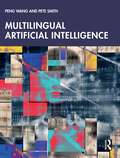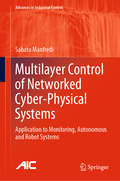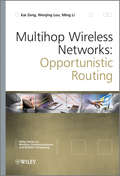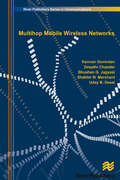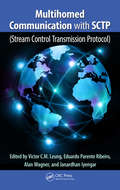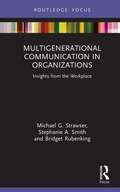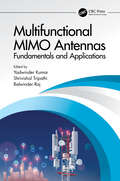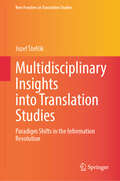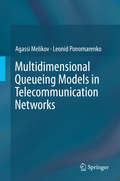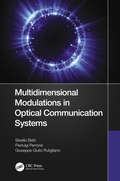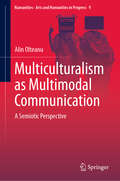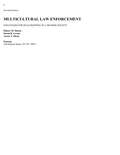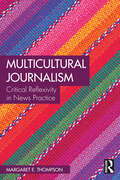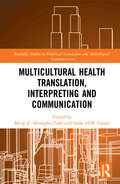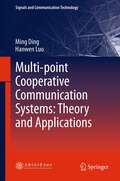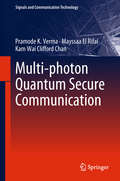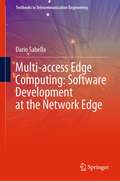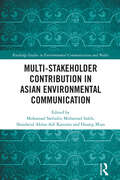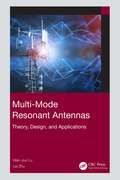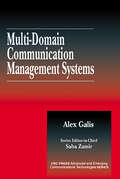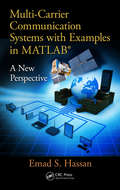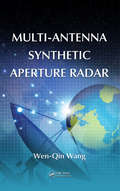- Table View
- List View
Multilingual Artificial Intelligence
by Pete Smith Peng WangMultilingual Artificial Intelligence is a guide for non-computer science specialists and learners looking to explore the implementation of AI technologies to solve real-life problems involving language data.Focusing on multilingual, multicultural, pre-trained large language models and their practical use through fine-tuning and prompt engineering, Wang and Smith demonstrate how to apply this new technology in areas such as information retrieval, semantic webs, and retrieval augmented generation, to improve both human productivity and machine intelligence. Finally, they discuss the human impact of language technologies in the cultural context, and provide an AI competence framework for users to design their own learning journey.This innovative text is essential reading for all students, professionals, and researchers in language, linguistics, and related areas looking to understand how to integrate multilingual and multicultural artificial intelligence technology into their research and practice.
Multilayer Control of Networked Cyber-Physical Systems: Application to Monitoring, Autonomous and Robot Systems (Advances in Industrial Control)
by Sabato ManfrediThis book faces the interdisciplinary challenge of formulating performance-assessing design approaches for networked cyber-physical systems (NCPSs). Its novel distributed multilayer cooperative control deals simultaneously with communication-network and control performance required for the network and application layers of an NCPS respectively. Practically, it distributes the computational burden among different devices, which act cooperatively to achieve NCPS goals. The approach can be applied to NCPSs based on both wired and wireless technologies and so is suitable for future network infrastructures in which different protocols and technologies coexist. The book reports realistic results from performance evaluation of the new approach, when applied in different operative scenarios. Readers of this book will benefit by: learning a general, technology-independent methodology for the design and implementation of cooperative distributed algorithms for flow control at the network layer of an NCPS that gives algorithm-parameter-tuning guidelines for assessing the desired quality of service performance; learning a general methodology for the design and implementation of consensus-based algorithms at the application layer that allows monitoring and control of distributed physical systems and gives algorithm-parameter-tuning guidelines for assessing the desired control system performance; understanding the main network simulators needed to validate the effectiveness of the proposed multilayer control approach in different realistic network operation scenarios; and practising with a cooperative multilayer control project that assesses acceptable NCPS performance in networked monitoring and robot systems, autonomous and queuing networks, and other critical human relief applications. Researchers, graduate students and practitioners working in automation, engineering, sensor networks, mobile robotics and computer networks will find this book instructive. It will also be helpful to network administrators and technicians implementing application-layer and network-layer solutions or installing, configuring or troubleshooting network and control system components of NCPSs.
Multilayer Control of Networked Cyber-Physical Systems
by Sabato ManfrediThis book faces the interdisciplinary challenge of formulating performance-assessing design approaches for networked cyber-physical systems (NCPSs). Its novel distributed multilayer cooperative control deals simultaneously with communication-network and control performance required for the network and application layers of an NCPS respectively. Practically, it distributes the computational burden among different devices, which act cooperatively to achieve NCPS goals. The approach can be applied to NCPSs based on both wired and wireless technologies and so is suitable for future network infrastructures in which different protocols and technologies coexist. The book reports realistic results from performance evaluation of the new approach, when applied in different operative scenarios. Readers of this book will benefit by: learning a general, technology-independent methodology for the design and implementation of cooperative distributed algorithms for flow control at the network layer of an NCPS that gives algorithm-parameter-tuning guidelines for assessing the desired quality of service performance; learning a general methodology for the design and implementation of consensus-based algorithms at the application layer that allows monitoring and control of distributed physical systems and gives algorithm-parameter-tuning guidelines for assessing the desired control system performance; understanding the main network simulators needed to validate the effectiveness of the proposed multilayer control approach in different realistic network operation scenarios; and practising with a cooperative multilayer control project that assesses acceptable NCPS performance in networked monitoring and robot systems, autonomous and queuing networks, and other critical human relief applications. Researchers, graduate students and practitioners working in automation, engineering, sensor networks, mobile robotics and computer networks will find this book instructive. It will also be helpful to network administrators and technicians implementing application-layer and network-layer solutions or installing, configuring or troubleshooting network and control system components of NCPSs.
Multihop Wireless Networks
by Ming Li Kai Zeng Wenjing LouThis book provides an introduction to opportunistic routing an emerging technology designed to improve the packet forwarding reliability, network capacity and energy efficiency of multihop wireless networksThis book presents a comprehensive background to the technological challenges lying behind opportunistic routing. The authors cover many fundamental research issues for this new concept, including the basic principles, performance limit and performance improvement of opportunistic routing compared to traditional routing, energy efficiency and distributed opportunistic routing protocol design, geographic opportunistic routing, opportunistic broadcasting, and security issues associated with opportunistic routing, etc. Furthermore, the authors discuss technologies such as multi-rate, multi-channel, multi-radio wireless communications, energy detection, channel measurement, etc. The book brings together all the new results on this topic in a systematic, coherent and unified presentation and provides a much needed comprehensive introduction to this topic.Key Features:Addresses opportunistic routing, an emerging technology designed to improve the packet forwarding reliability, network capacity and energy efficiency of multihop wireless networksDiscusses the technological challenges lying behind this new technology, and covers a wide range of practical implementation issuesExplores many fundamental research issues for this new concept, including the basic principles of opportunistic routing, performance limits and performance improvement, and compares them to traditional routing (e.g. energy efficiency and distributed opportunistic routing protocol design, broadcasting, and security issues)Covers technologies such as multi-rate, multi-channel, multi-radio wireless communications, energy detection, channel measurement, etc.This book provides an invaluable reference for researchers working in the field of wireless networks and wireless communications, and Wireless professionals. Graduate students will also find this book of interest.
Multihop Mobile Wireless Networks
by Kannan Govindan Deepthi Chander Bhushan G. JagyasiMultihop Mobile Wireless Networks discusses issues pertaining to each of these networks and proposes novel and innovative algorithms on Scheduling, Routing and Data aggregation that are viable solutions for multihop mobile networks.
Multihomed Communication with SCTP (Stream Control Transmission Protocol)
by Victor C.M. Leung Alan Wagner Janardhan Iyengar Eduardo Parente RibeiroAlthough multihomed communication is a rapidly emerging trend for next generation networks, no known book explores multihomed communication with the Stream Control Transmission Protocol (SCTP). Filling this void, Multihomed Communication with SCTP (Stream Control Transmission Protocol) explains this innovative feature that allows an endpoint to sim
Multigenerational Communication in Organizations: Insights from the Workplace (Routledge Focus on Communication Studies)
by Michael G. Strawser Stephanie A. Smith Bridget RubenkingMultigenerational Communication in Organizations explores generational differences in the changing workplace from a communication perspective. Starting from the reality that a workplace can contain up to five different generations, these chapters examine topics like generational perceptions on the job search process; organizational culture; organizational identification; organizational crises; the dark side of workplace communication; remote working; and future challenges. Outlines of best practices and suggestions for application are provided based on the most recent data and corresponding literature. The authors also develop a data-forward understanding of Generation Z in context. This book is ideal for both scholars and practitioners in organizational communication and management, as well as for workplace managers and supervisors.
Multifunctional MIMO Antennas: Fundamentals and Applications
by Yadwinder KumarThis book presents a comprehensive approach to antenna designs for various applications, including 5G communication, the internet of things (IoT), and wearable devices. It discusses models, designs, and developments of MIMO antennas, antenna performance measurement, 5G communication challenges and opportunities, and MIMO antennas for LTE/ISM applications. It covers important topics including mmWave antennas, antenna arrays for MIMO applications, reconfigurable/band-notched MIMO antennas, multiband MIMO antennas, wideband MIMO antennas, and fractal-based compact multiband hybrid antennas. FEATURES Discusses antenna design optimization techniques in detail Covers MIMO antenna performance measurement, multiband MIMO antennas, and wideband MIMO antennas Discusses modeling, simulation, and specific absorption rate (SAR) analysis of antennas Provides applications including radio-frequency identification (RFID), wearable antennas, and antennas for IoT Multifunctional MIMO Antennas: Fundamentals and Application is useful for undergraduate and graduate students and academic researchers in areas including electrical engineering, electronics, and communication engineering.
Multidisciplinary Insights into Translation Studies: Paradigm Shifts in the Information Revolution (New Frontiers in Translation Studies)
by Jozef ŠtefčíkThe book explores translation theory, the translation industry's current state and potential future, and translation research and pedagogy. It delves into disruptive technologies, globalisation, and changing market trends that are shaping translation studies. The book highlights significant advancements in the translation industry and translation training technology, particularly machine translation and artificial intelligence in practice, focusing on interdisciplinary human-based approach and its impact on the increased demand for translations. The book offers views on new opportunities for labour positions in the translation industry and training models that should be carried out to corresponding research. Moreover, the book emphasises the increasing demand for translation services in selected domains and niche industries. While acknowledging the potential disruptions brought by technological advancements, the ideas presented in the book underline the importance of adaptability and continuous learning for language professionals. It calls for the education system to embrace the challenges and equip future language professionals with the necessary skills to thrive in a changing landscape. The presented concepts aim to encourage readers to embrace technological advancements, human cooperation, specialisation in niche areas, and actively participate in professional networking to contribute significantly to the growth of the fast-evolving language industry. This book is intended for curricula designers at universities, academics and students in the fields of translatology, philology, linguistics, humanities, languages, and cultural studies, and trainers of translation and interpreting. This book is also useful for lexicographers and terminographers, and freelancers in LSP.
Multidimensional Queueing Models in Telecommunication Networks
by Leonid Ponomarenko Agassi MelikovThe increasing complexity of telecommunication networks requires us to develop adequate mathematical models. We must find their characteristics, optimize them subject to chosen criteria, and develop the corresponding control algorithms. Multidimensional queueing models are used to design and optimize modern and next-generation networks (NGN). The central problem of the related mathematical theory is to apply multidimensional and large-size queueing models to improve efficiency. In this book new methods are successively developed and applied to solve related problems. The book is recommended for researchers engaged with the mathematical theory of telecommunications traffic.
Multidimensional Modulations in Optical Communication Systems
by Silvello Betti Pierluigi Perrone Giuseppe Giulio RutiglianoThis book analyzes novel possibilities offered to the telecommunication engineer in designing tomorrow’s optical networks. Currently, optical and optoelectronic technologies make possible the realization of high-performance optical fiber communication systems and networks with the adoption of WDM configurations and both linear and nonlinear optical amplifications. The last step for increasing network throughput is represented by the implementation of multidimensional modulation formats in coherent optical communication systems, which enable increasing the bit rate/channel toward 400 Gbit/s/channel and beyond. Following this approach, the main emphasis is placed on innovative optical modulations. Multidimensional Modulations in Optical Communication Systems is an essential guide to the world of innovative optical communications from the point of view of growing capacity and security. It guides researchers and industries with the aim to exploring future applications for optical communications.
Multiculturalism, Higher Education and Intercultural Communication: Developing Strengths-Based Narratives for Teaching and Learning (Palgrave Studies in Global Citizenship Education and Democracy)
by Damian SpiteriThis book explores how multiculturalism should be promoted throughout higher education due to its benefits for students. It adopts a strengths-based student-centred perspective and offers practical illustrations of how multicultural education can instigate students to understand each other and to relate to each other meaningfully. With the rise of international students in higher education across the globe it is crucial that institutions promote multicultural education for their wider communities.
Multiculturalism, Higher Education and Intercultural Communication
by Damian SpiteriThis book explores how multiculturalism should be promoted throughout higher education due to its benefits for students. It adopts a strengths-based student-centred perspective and offers practical illustrations of how multicultural education can instigate students to understand each other and to relate to each other meaningfully. With the rise of international students in higher education across the globe it is crucial that institutions promote multicultural education for their wider communities.
Multiculturalism as Multimodal Communication: A Semiotic Perspective (Numanities - Arts and Humanities in Progress #9)
by Alin OlteanuThis highly readable book develops a numanistic, and specifically semiotic approach to multiculturalism. It reveals how semiotics provides fresh and valuable insights into multiculturalism: in contrast to the binary logic of dualistic philosophy, semiotic logic does not understand the value of truth in rigid terms of ‘true’ or ‘false’, ‘right’ or ‘wrong’ only. The value of truth resides in meaning, which is a dynamic, evolutionary phenomenon, rooted, nevertheless, in factuality.Drawing on recent developments in biosemiotics, the book presents a theoretical approach to multiculturalism, regarding the lives of people living in multicultural environments. Rather than analyzing political or economic phenomena, it offers a semiotic analysis of multiculturalism and discusses its educational implications. It also invites readers to regard learning as a phenomenon of ecological sign growth and to understand multiculturalism along the same lines. As such, it brings together the life and social sciences and the humanities in a unified perspective, in an approach fitting postmodernism.Developing a postmodern philosophy for contemporary non-experts, which allows distancing from political discourse in favor of a posthumanistic stand, where altruism is seen as an opportunity, not a threat, this book appeals to a wide readership, from scholars seeking state-of-the-art theories to general readers looking for a thought-provoking and enlightening read.
Multicultural Law Enforcement: Strategies For Peacekeeping In A Diverse Society (What's New In Criminal Justice Ser.)
by Robert Shusta Deena Levine Aaron OlsonMulticultural Law Enforcement: Strategies for Peacekeeping in a Diverse Society provides practical information and insight to prepare officers for culturally sensitive policing. The content explores the pervasive influences of culture, race, ethnicity, gender, and sexual orientation in the workplace and in multicultural communities. It also delves into topics such as gangs, victims of human trafficking, homelessness, mental illness, and international events and their impact on law enforcement in the U.S. The 7th edition reflects new and expanded information on issues facing law enforcement professionals and the communities they serve, such as implicit biases and police-community mutual stereotypes.
Multicultural Journalism: Critical Reflexivity in News Practice
by Margaret E. ThompsonThis book introduces a more collaborative and reflexive way of producing news that incorporates concepts of cultural identity and cultural positioning of both journalists and sources using a feminist approach to inclusion of all voices and perspectives. This text proposes a feminist collaborative model of journalism that incorporates critical reflexivity, requiring journalists not only to be aware of their own cultural positionality but also that of their sources, as a means of producing more authentic and balanced news coverage. The model is intended for use by journalists as well as journalism education programs to educate future journalists on how to effectively serve audiences with scrupulously investigated, reported, and crafted stories. Chapters explore journalism during the Obama and Trump years, current journalistic trends, and alternative media, and feature topics such as fake news, racism, sexism in news production and content, and immigration and media. Thompson addresses issues of power and privilege amongst journalists and marginalized groups, and how these implicate power dynamics of journalism practice and reinforce social inequality, particularly relating to race and gender. This book is ideal for advanced undergraduate and graduate students of journalism and media studies, as well as scholars, journalists, and media practitioners.
Multicultural Health Translation, Interpreting and Communication (Routledge Studies in Empirical Translation and Multilingual Communication)
by Mustapha Taibi Meng Ji Ineke H. CrezeeMulticultural Health Translation, Interpreting and Communication presents the latest research in health translation resource development and evaluation, community and professional health interpreting, and the communication of health risks to multicultural populations. Covering a variety of research topics in empirical health translation and interpreting, this advanced resource will be helpful for research students and academics of translation and interpreting studies who have an interest in health issues, particularly in multicultural and multilingual societies. This edited volume brings in interdisciplinary expertise from areas such as translation studies, community interpreting, health communication and education, nursing, medical anthropology and psychology, and will be of interest to healthcare professionals, language services in multilingual societies and researchers interested in communication between healthcare providers and users.
Multi-point Cooperative Communication Systems: Theory and Applications
by Hanwen Luo Ming DingMulti-point Cooperative Communication Systems: Theory and Applications mainly discusses multi-point cooperative communication technologies which are used to overcome the long-standing problem of limited transmission rate caused by the inter-point interference. Instead of combating the interference, recent progress in both academia and industrial standardizations has evolved to adopt the philosophy of "exploiting" the interference to improve the transmission rate by cooperating among multiple points. This book addresses the multi-point cooperative communication system systematically giving the readers a clear picture of the technology map and where the discussed schemes may fit. This book includes not only the theories of the paradigm-shifting multi-point cooperative communication, but also the designs of sub-optimal cooperative communication schemes for practical systems. Ming Ding is a senior researcher at Sharp Laboratories of China; Hanwen Luo is a professor at Shanghai Jiao Tong University.
Multi-photon Quantum Secure Communication (Signals and Communication Technology)
by Pramode K. Verma Mayssaa El Rifai Kam Wai ChanThis book explores alternative ways of accomplishing secure information transfer with incoherent multi-photon pulses in contrast to conventional Quantum Key Distribution techniques. Most of the techniques presented in this book do not need conventional encryption. Furthermore, the book presents a technique whereby any symmetric key can be securely transferred using the polarization channel of an optical fiber for conventional data encryption. The work presented in this book has largely been practically realized, albeit in a laboratory environment, to offer proof of concept rather than building a rugged instrument that can withstand the rigors of a commercial environment.
Multi-access Edge Computing: Software Development at the Network Edge (Textbooks in Telecommunication Engineering)
by Dario SabellaThe textbook covers the main aspects of Edge Computing, from a thorough look at the technology to the standards and industry associations working in the field. The book is conceived as a textbook for graduate students but also functions as a working guide for developers, engineers, and researchers. The book aims not only at providing a comprehensive technology and standard reference overview for students, but also useful research insights and practical exercises for edge software developers and investigators in the area (and for students looking to apply their skills). A particular emphasis is given Multi-access Edge Computing (MEC) as defined in European Telecommunications Standards Institute (ETSI), in relationship with other standard organizations like 3GPP, thus in alignment with the recent industry efforts to produce harmonized standards for edge computing leveraging both ETSI ISG MEC and 3GPP specifications. Practical examples of Edge Computing implementation from industry groups, associations, companies and edge developers, complete the book and make it useful for students entering the field. The book includes exercises, examples, and quizzes throughout.
Multi-Stakeholder Contribution in Asian Environmental Communication (Routledge Studies in Environmental Communication and Media)
by Huang Miao Mohamad Saifudin Mohamad Saleh Shaidatul Akma Adi KasumaMulti-Stakeholder Contribution in Asian Environmental Communication focuses on how diverse actors can come together to promote sustainable environmental practices.Bringing together 25 environmental communication scholars and practitioners across 15 innovative chapters, this book explores the dynamic roles of stakeholders – ranging from governmental bodies and non-profit organisations to local communities and industry players – involved in advancing environmental communication across the Asian continent. Drawing on a rich tapestry of case studies and interdisciplinary perspectives, the book sheds light on the interplay of religious, cultural, political, and economic factors that shape environmental communication strategies and public perception in Malaysia, Indonesia, Bangladesh, China, Thailand, Iran, Japan, and Pakistan. It probes into contemporary issues such as Islamic environmental communication, gender roles, social media, political communication, the role of games and gaming companies, as well as the portrayal of ecological messages in film. Overall, this book aims to bridge the gap between theory and practice and will make a significant contribution to the growing literature on multi-stakeholder contribution in environmental communication, particularly in the Asian context.This volume will be of great interest to practitioners, policymakers, and researchers working in the field of environmental communication.
Multi-Mode Resonant Antennas: Theory, Design, and Applications
by Lei Zhu Wen-Jun LuThis title provides a unique theoretical framework for multi-mode resonant antennas and different approaches to their implementation, with an emphasis on mode gauge functionality, a new concept for a clear identification and flexible control of all usable resonant modes in multi-mode resonant antenna design. The book commences by advancing a generalized odd-even mode theory as a general theoretical framework for resonant elementary antennas, offering new insights into the classical problem of coupling effects between antenna and transmission lines and helping reveal the operation mechanism of elementary antennas under multi-mode resonance. Then, the concept of "mode gauge" is developed and employed for wideband elementary antenna design by simultaneously exciting and tuning multiple resonant modes within a single radiator. Apart from theoretical explorations, the authors also provide analysis of up-to-date implementation of multi-mode resonant elementary antennas with different functionalities, including wideband antennas, circularly polarized antennas, multiband antennas, frequency scanning antennas and low-profile antennas. Academics, students and professional engineers at all levels will greatly benefit from the book and will be provided with historical background, state-of-the-art methodology, useful design tools and multiple applications of multi-mode resonant antennas.
Multi-Domain Communication Management Systems (Advanced & Emerging Communications Technologies)
by Alex GalisAmong the leading challenges faced by systems managers today is the coherent management of network resources in a multi-domain, multi-environment. The MISA Project - Management of Integrated SDH and ATM Networks - brought together researchers from 17 organizations to explore and advance the state of the art in developing enabling mechanisms for end
Multi-Carrier Communication Systems with Examples in MATLAB: A New Perspective
by Emad HassanDetailing the advantages and limitations of multi-carrier communication, this book proposes possible solutions for these limitations. Multi-Carrier Communication Systems with Examples in MATLAB: A New Perspective addresses the two primary drawbacks of orthogonal frequency division multiplexing (OFDM) communication systems: the high sensitivity to c
Multi-Antenna Synthetic Aperture Radar
by Wen-Qin WangSynthetic aperture radar (SAR) is a well-known remote sensing technique, but conventional single-antenna SAR is inherently limited by the minimum antenna area constraint. Although there are still technical issues to overcome, multi-antenna SAR offers many benefits, from improved system gain to increased degrees-of-freedom and system flexibility. Multi-Antenna Synthetic Aperture Radar explores the potential and challenges of using multi-antenna SAR in microwave remote sensing applications. These applications include high-resolution imaging, wide-swath remote sensing, ground moving target indication, and 3-D imaging. The book pays particular attention to the signal processing aspects of various multi-antenna SAR from a top-level system perspective. Explore Recent Extensions of Synthetic Aperture Radar Systems The backbone of the book is a series of innovative microwave remote sensing approaches developed by the author. Centered around multi-antenna SAR imaging, these approaches address specific challenges and potential problems in future microwave remote sensing. Chapters examine single-input multiple-output (SIMO) multi-antenna SAR, including azimuth and elevation multi-antenna SAR, and multiple-input multiple-output (MIMO) SAR. The book details the corresponding system scheme, signal models, time/phase/spatial synchronization methods, and high-precision imaging algorithms. It also investigates their potential applications. Introductory Tutorials and Novel Approaches in Multi-Antenna SAR Imaging Rigorous and self-contained, this is a unique reference for researchers and industry professionals working with microwave remote sensing, SAR imaging, and radar signal processing. In addition to novel approaches, the book also presents tutorials that serve as an introduction to multi-antenna SAR imaging for those who are new to the field.
